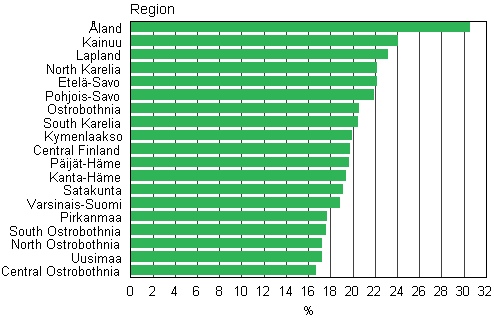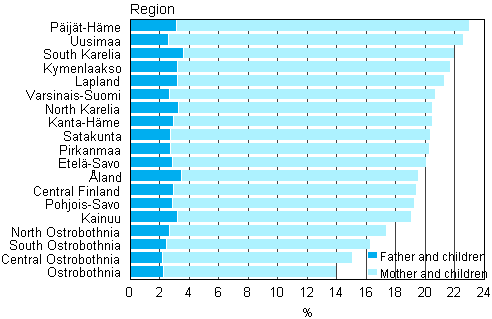4. Married couple the most common type of family in all regions
4.1 Number of cohabiting families lowest in Central Ostrobothnia
The commonest type of family with children in all regions is one of a married couple although there are also clear differences in this. The differences arise from the prevalence of families of cohabiting couples and one-parent families in the regions. In relative numbers, most cohabiting couples are found in Åland, Kainuu and Lapland. In Åland, 30 per cent and in Kainuu and Lapland, 23 per cent of all families with underage children are families of cohabiting couples. The lowest share of cohabiting families in Finland is found in Central Ostrobothnia, 16 per cent.
Figur 7. Families of cohabiting couples as a proportions of families with underage children by region in 2013

When examining the prevalence of cohabiting couples by municipality, the municipalities of Åland are in the lead. Among municipalities in Mainland Finland, Savukoski holds the lead with 36 per cent of families with underage children cohabiting. In Närpiö and Suomussalmi the respective proportion is 32 per cent and in Luhanka 31 per cent. The municipality in Mainland Finland with the lowest share of six per cent of families of cohabiting couples with children is Luoto.
4.2 One-parent families most common in Päijät-Häme and Uusimaa
There is also clear regional variation in the prevalence of one-parent families. The Ostrobothnian regions differ from other regions in favour of the conventional family (Figure 8). The number of one-parent families is lowest there. The number of one-parent families is highest in Päijät-Häme (23.0 %) and Uusimaa (22.6 %). Lahti puts the share up for Päijät-Häme and Helsinki for Uusimaa.
Figure 8. Proportion of single-parent families of all families with underage children by region in 2013

The regional variation in the proportion of one-parent families with children is due to the different proportions in families of the type mother and children. The proportion of families of the type father and children ranges from two to three per cent in nearly all regions. The shares were biggest in North Karelia (3.3 %), and Åland (3.5 %) and South Karelia (3.7 %).
Examined by municipality in Mainland Finland, the proportions of one-parent families with children are the highest in Helsinki, Hartola, Kemi and Turku (28 %). Åland has the highest figures in the whole of Finland (Sottunga 40%, Kökar 35% and Mariehamn 28 %) but in the case of Sottunga and Kökar it should be borne in mind that in such small municipalities the difference of just a couple of family types can alter the percentage share considerably.
In Mainland Finland, the lowest relative proportions of one-parent families can be found in Luoto and Pedesröre (5 %), and in Åland in Vårdö (7 %).
Luoto could be viewed as the most conventional municipality in terms of family structure, because it has the lowest proportion of one-parent families with children (5%) and the highest proportion of married couples (89 %) in the whole country. Luoto also has the sixth highest average number of 2.70 of underage children living at home per family. Higher figures are reached in Lumijoki (2.97), Perho (2.90) and Sievi (2.88). The average for the whole country is 1.84.
Source: Population and Cause of Death Statistics, Statistics Finland
Inquiries: Marjut Pietiläinen 029 551 2798, Timo Nikander 029 551 3250, vaesto.tilasto@stat.fi
Director in charge: Riitta Harala
Updated 21.11.2014
Official Statistics of Finland (OSF):
Families [e-publication].
ISSN=1798-3231. Annual Review 2013,
4. Married couple the most common type of family in all regions
. Helsinki: Statistics Finland [referred: 30.12.2025].
Access method: http://stat.fi/til/perh/2013/02/perh_2013_02_2014-11-21_kat_004_en.html

